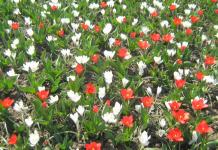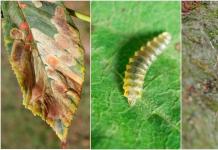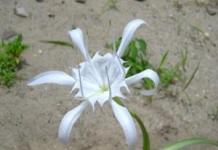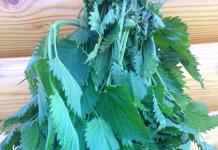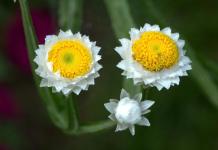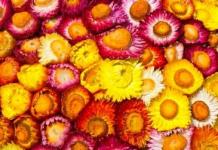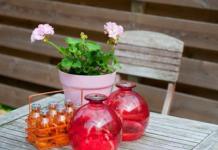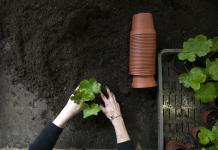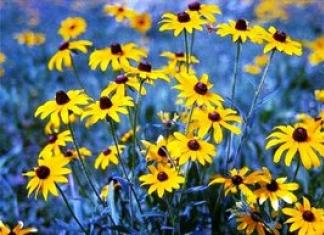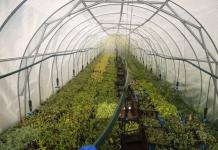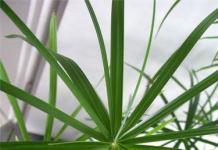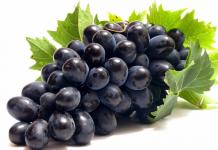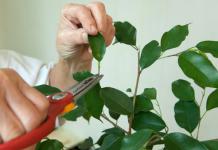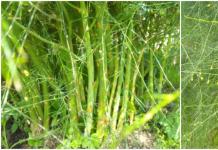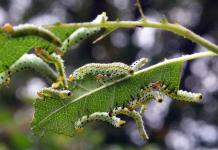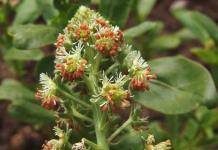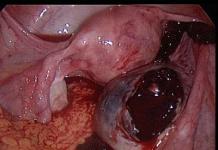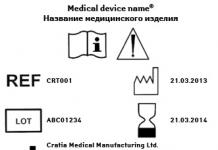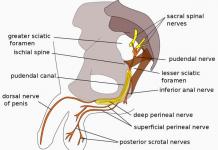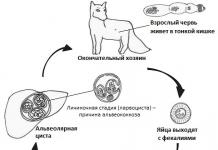
Algae in the aquarium- this is probably one of the main problems of the aquarist. There are many discussions on this topic. However, as a rule, attempts to cope with algae are not so successful. This is due to the fact that many aquarists do not understand the essence of the problem and use various means at random, which only increases the number of ineffective control methods.
There are two categories of algae of concern to aquarists: "good" and "bad". Good algae are present in small quantities and are indicative of good water quality and can be easily controlled with fish using algae for food or by simply removing them during routine maintenance. These algae are a natural consequence - in a container with water, nutrients and a light source. Bad algae is usually an indicator of poor water quality.

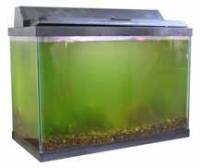

Green unicellular algae sometimes multiply so quickly that the water turns green. This is commonly referred to as "bloom" and is usually caused by excess light and direct sunlight. When darkening the aquarium, they can be removed by filtration with a micron cartridge or diatom filters. UV sterilizers take the first place in the fight against water bloom. Green water - very useful for growing daphnia and shrimp larvae. A thin film of algae forms on the glass of the aquarium. Easy to remove by wiping the glass.
Overhead lighting from 0.5W / L is considered normal for an aquarium, which is necessary for good plant growth.
Algae in the form of spots.


They grow as thin, tough, round, bright green spots, usually on aquarium glass and on plants in high light. Considered normal for a plant aquarium. Removed mechanically... In acrylic aquariums, use a cloth. In glass tanks, the blade is most effective.
Bundles / tassels of algae.



They grow mainly on the leaves of plants in the form of separate, short (2-5mm) or long (4cm) strands. Easy to control with algae eating fish.
Filamentous algae.


They grow in long, thin strands up to 30 cm. Closer to a dull green color. An excess of iron is usually indicated. Easily removed with a toothbrush, by rotating / winding.
2. Brown / Diatoms.


They are found in the form of a soft brown coating. Usually the presence of brown / diatoms indicates a lack of light or an excess of silicates. When the light level is increased, they usually disappear. Easy to remove by wiping the glass or siphoning the affected area.
3. Blue-green algae.

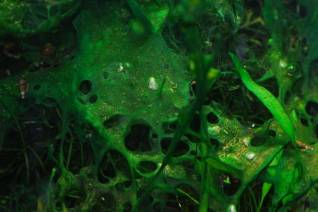
They grow and spread quickly as a blue-green film / slime, which usually indicates poor water quality in the aquarium. Blue-green algae are capable of assimilating nitrogen and can be found in aquariums with extremely low nitrate levels. They can be physically removed, but this is not a solution to the problem, if conditions remain favorable, then these algae will quickly return. Treatment with 200 mg of erythromycin per 10 liters of water is usually sufficient to eliminate blue-green algae, but some believe that this may also have an adverse effect on the biological filter. If erythromycin is used for treatment, ammonia and nitrite levels should be monitored. Blue-green algae can only exist in stagnant water, so by circulating water in your aquarium, you can stop the development of these algae.
4. Red algae.



They grow in the form of feathery bunches / brushes of olive, gray or reddish color. In nature, they grow mainly in the sea, but some species exist in fresh waters. The most unpleasant for the aquarist are "Blackbeard" and / or "Vietnamese", which are tenaciously fixed on glasses, driftwood and leaves. Dark gray brushes / tufts multiply rapidly and spoil the appearance of the entire aquarium.
Unfortunately, the formation of algae in the aquarium is a natural process and therefore it is almost impossible to get rid of them once and for all. Even if absolutely sterile, algae spores can still enter the aquarium with plants, fish or water. Potent agents that can destroy the algal cell primarily disrupt the ecosystem / biological balance of the reservoir, harm fish and higher plants. 
It is impossible to get rid of algae completely, but you can reduce their development:
1. Maintain your aquarium regularly, remembering to change the water.
2. The water should contain enough macro and microelements necessary for the development of aquatic aquatic organisms.
3. Place fast growing plant species such as, and. These plants actively absorb nutrients from the water, thereby depriving algae of nutrition.
4. It has been noticed that algae develop better under blue cold light, so it is better not to use lamps of this spectrum at all or install them only near the front glass. All other lighting should be warm or neutral.
5. No matter how strange it sounds, but algae in the shape of a ball is also a competitor to "bad" algae, as it actively and in large quantities consumes phosphates and other nutrients.
6.chemical agent - it is believed to release antibiotic substances that
prevents the appearance of blue-green algae.
7. Control of Phosphates with is well known and widely used. It is generally available in the form of free-flowing filler granules. Usually used in a mesh bag in the filter housing, it absorbs phosphates.
8. For aquariums with only fish can be set, it will kill algae spores in the water. But for an aquarium with plants, this is not really good decision as ultraviolet light will also oxidize trace elements needed by plants and will restrict the growth of aquarium plants.
To avoid introducing the algae into the aquarium with new plants, it is a good idea to process them with a simple bleach. Mix 1 part bleach with 19 parts water and soak the new plant in it for 2 minutes. Then immediately rinse the plant in running water to remove any remaining bleach. This will kill the algae and only slightly slow down the development of the healthy plant. A plant in poor condition is best just thrown away.
9. The most effective method of controlling algae in a plant aquarium is to use fish and
invertebrates eating algae. This is especially important when starting a new aquarium so that the plants have a chance to adapt to the new conditions.

Some of the most common helpers, but not a panacea! in the fight against algae:
 - perfect for a community aquarium, as they get along with most types of fish. They perfectly eat green soft algae, they will also get rid of the surface film.
- perfect for a community aquarium, as they get along with most types of fish. They perfectly eat green soft algae, they will also get rid of the surface film.  - have become very popular in the aquarium hobby. They perfectly eat any green and diatom algae, although they mainly feed on algae that are in the initial stage of development. The Otozinklus prefers a school of at least 6 fish.
- have become very popular in the aquarium hobby. They perfectly eat any green and diatom algae, although they mainly feed on algae that are in the initial stage of development. The Otozinklus prefers a school of at least 6 fish.
 Siamese algae (Crossocheilus siamensis)- Peace-loving fish, otherwise known as SAE (Siamese Algae Eaters), considered by many to be the best algae eaters, they eat all types of algae. SAE is diligent even when it comes to red algae that other algae eaters will not touch.
Siamese algae (Crossocheilus siamensis)- Peace-loving fish, otherwise known as SAE (Siamese Algae Eaters), considered by many to be the best algae eaters, they eat all types of algae. SAE is diligent even when it comes to red algae that other algae eaters will not touch.
 Catfish sucker- this is a common name for a wide range of Loricaria catfish with a sucker mouth (, Loricaria, Pekoltia, etc.). Some of the most popular cleaners. Few know that some of them grow to a large size, which is important to consider when choosing fish for your aquarium.
Catfish sucker- this is a common name for a wide range of Loricaria catfish with a sucker mouth (, Loricaria, Pekoltia, etc.). Some of the most popular cleaners. Few know that some of them grow to a large size, which is important to consider when choosing fish for your aquarium.
 gained popularity when Japanese aquarist Takashi Amano introduced them in his book Nature Aquarium World. They are very useful in controlling the development of algae in the aquarium. This unassuming freshwater shrimp eats algae relentlessly and even cleans sand or gravel.
gained popularity when Japanese aquarist Takashi Amano introduced them in his book Nature Aquarium World. They are very useful in controlling the development of algae in the aquarium. This unassuming freshwater shrimp eats algae relentlessly and even cleans sand or gravel.
 great for combating various algal fouling on the walls of the aquarium, clean driftwood, stones and do not damage plants. They are also quite attractive and will be a great addition to your aquarium.
great for combating various algal fouling on the walls of the aquarium, clean driftwood, stones and do not damage plants. They are also quite attractive and will be a great addition to your aquarium.
If the above measures do not help your algae control success, you can use various methods to eliminate them directly and effectively. But before doing this, it is advisable that you manually remove as much algae as possible.

Anyone seriously considering a healthy aquarium should consider investing in a water testing kit and learn more about the nitrogen cycle and other aquarium processes. Learning to control the level of ammonia, nitrates and nitrites and then you have a better chance of keeping the water parameters under control - and with it the well-being of the entire aquarium.
The topic of algae control is very extensive, and you can talk about it endlessly, but the above recommendations are enough for a practical fight.


![]()
Aquarium mode.
Under the regime of the aquarium it is necessary to understand everything that is associated with providing conditions for normal life.
fish and plants that live in the aquarium.
These conditions can be achieved by maintaining cleanliness in the aquarium, with the right soil, the required water hardness and pH, rational use of lighting, and maintaining the temperature of water and air within the required range. A properly set regime of the aquarium promotes, first of all, the rapid growth of higher vegetation, and this is one of the means of preventing the appearance of algae in the aquarium.
Overgrown aquarium plants protect themselves from algae to one degree or another. Growing up, they use more lighting, mineral and organic substances, carbon dioxide and create a shade under them, thereby preventing the dispersal of, for example, green and blue-green algae, which also need good lighting.
In addition, some species of higher plants apparently release substances into the water that prevent the development of algae. In one of the aquariums where Beckett's Cryptocoryne and several Barclay long-leaved bushes grew, I happened to observe such a phenomenon.
Blue-green algae appeared on the ground of the aquarium and covered almost the entire bottom area with a thin layer, and about the two plants mentioned above, circles with a diameter of 12-15 cm, free from them, formed. I removed most of the algae from the aquarium, and after two weeks, the remaining ones completely disappeared, the plants continued to grow vigorously.
The likelihood of algae appearing in the aquarium is significantly higher when the aquarium is under-planted with aquatic higher plants or the plants grow poorly and look sickly. Therefore, you need to remember that the larger the volume of the aquarium, the more plants should grow in it.
If the plants require strong and long-term lighting, then depending on the weather conditions, artificial lighting must be varied, and the aquarium must be periodically shaded with curtains from natural light. Higher vegetation usually does not suffer from temporary, complete or partial shading, and algae, especially in the initial phase of development, die.
The possibility of blue-green algae formation is significantly reduced in an aquarium equipped with a compressor to aerate the water or a pump that provides a strong mechanical movement of the water. Large aquariums should preferably be equipped with a mechanical filter.
The mechanical filter should be turned on periodically, but with the appearance of algae causing water bloom, it should be constantly running until they disappear. The density of the filter media depends on the type of algae. Use garden soil, heavy fibrous-clay soil and other fatty substrates with great care, since such soil is usually rich in humus, contains an excess of nitrogen, organic matter and promotes the development of algae, as well as turbidity.
The use of fatty substrates in the aquarium is recommended only in pots, covered with cleanly washed river sand on top. Algae is more likely to develop on fine sand than on gravel. At the slightest sign of algae, mechanical cleaning of the aquarium is necessary. The correct regime will reduce the likelihood of algae appearing in the aquarium.
If the growth of algae became uncontrollable and they continue to develop rapidly in the water column, causing it to bloom or settling on the ground, glass of the aquarium or on higher aquatic vegetation, it is necessary to take a sample of the soil and water and determine the genus or type of algae in order to find out how dangerous it is for aquarium.
Green algae, especially ulotrix, spirogyra and cladophora, are close in structure to higher plants. Apparently, therefore, they are more often than other types of algae are uninvited "guests" of the aquarium. Types of green algae enter the aquarium in different ways: with soil, when water from natural reservoirs is used, they are brought in along with food, with purchased plants.
Some types of green algae can grow quite large, are very decorative and bring the aquarium closer to natural conditions.
These include, for example, the custard, which is cultivated by aquarists in both common aquarium, and in separate small glass jars. The successful cultivation of the custard indicates that it does not interfere with the development of higher vegetation, fish and other animals.
Some types of green algae form emerald-green sods attached to separate pebbles and settle on old leaves, petioles and stems of higher plants. They lead a bottom or bottom life. On young leaves, shoots usually do not settle. In admissible quantities, they do not bring harm to higher plants.
Green algae grow well under the same conditions as higher aquarium vegetation. Experiments have found that with normal growth of green algae, the likelihood of the appearance of colonies of blue-green algae is significantly reduced. Nevertheless, the spread of green algae in the aquarium in large quantities is unacceptable.
Algae grow well in a strongly lit aquarium, so you need to change its light mode in the direction of decreasing the intensity and duration of lighting.
Algae are removed from the plants by hand, and from the ground - with a specially made small rake together with the top layer of soil. Algae must be separated from the soil and the soil must be boiled for 5 minutes, after which it can be poured into the aquarium, and the top layer can be covered with coarse river sand.
Heavily infested leaves or other plant organs should be removed from the water.
Blue-green algae are the most dangerous for the aquarium. Settling on the surface of the soil, glass of the aquarium, leaves of plants, they form a kind of slimy colonies with a strong swamp smell. These algae prefer water containing a large number of calcium salts. Therefore, they often appear in newly equipped hard water aquariums.
With frequent refreshing of water, abundant lighting and in the absence of water circulation, they multiply rapidly. One of the radical means of preventing the appearance of these algae is to create a constant forced circulation of water using a pump or abundant aeration. Any algae that has appeared must be removed from the aquarium.
If after a few days they appear again, it is necessary to fill the aquarium with soft water and sharply change the lighting mode for 7 - 8 days.
The first 2 - 3 days the aquarium should be kept closed with thick, preferably black paper, and then covered with translucent tracing paper until the algae disappear.
You can do it differently, increase the intensity of artificial lighting. Infralamps, which prevent the development of blue-green algae, are best suited for these purposes.
In an aquarium or other artificial reservoirs prone to blue-green algae infestation, it is recommended to keep animals that destroy them. These animals include herbivores or partially herbivores. aquarium fish from the genera Molliesia and Otocinclus, especially the sucker Otocinclus maculipinnis Regan).
These fish feed on algae, thereby removing them from the walls of the aquarium, plants and stones. Catfish living on the ground of the aquarium are very useful; constantly stirring up the bottom surface, they also prevent the formation of algae colonies.
When a small amount of algae appears in the aquarium, they are dealt with and different kinds shellfish. Algae that appeared in spring or summer can be destroyed in 3 to 4 days if tadpoles, a grass frog or a toad are placed in the aquarium.
Foreign literature provides data on the use of antibiotics against blue-green algae in aquaristics. U. Shiver used penicillin at a concentration of 100 to 10,000 U / L to combat algae, and streptomycin at a concentration of 1.0 to 10.0 mg / ml.
Experiments were carried out to establish the possibility of combating these algae in a densely planted with higher aquatic plants and inhabited by fish aquarium with the help of penicillin.
Penicillin G (benzylpenicillin sodium) was used. At a concentration of 100 U / L, no noticeable effect in suppressing the growth of algae was observed, the use of 1000 U / L gave a weak effect: their spread stopped, the layers turned into grey colour... However, after 3 - 5 days, the algae began to grow rapidly again.
Penicillin at a concentration of 5000 U / L had a detrimental effect on them: the layers (colonies) became dirty gray, the algae fell off or coagulated and could easily be collected with a hose. This process developed slowly and reached its greatest extent in 4-6 days. After 10 days, all visible layers of algae disappeared, but after another 3 - 4 days, new ones appeared.
A positive result was obtained only when the concentration of penicillin was increased to 10,000 U / L. The blue-green algae died within 8 days and did not appear in the aquarium for 5 months.
Higher aquatic plants and fish were not affected during the experiment. The mode of the aquarium during this period was not disturbed, remained constant.
In the aquarium, unicellular or colonial species of diatoms can settle - on plant leaves, soil and glass. They prefer partial shade, so they usually appear in dimly lit aquariums or in winter, when the intensity and duration of light decreases.
These algae reduce the ability of the leaves to assimilate, thereby interfering with the normal development of plants. By settling on the glass of the aquarium, they reduce its transparency, reduce the intensity of light penetration to the higher vegetation. It is not possible to remove them from plant leaves, but they are removed from glass with a scraper, gauze or foam. These algae do not develop under normal aquarium lighting.
The aquarium infested with them must be moved to a brighter place or increased artificial lighting.
Blooming water. Can be caused by a wide variety of algae. Breeding in huge numbers, they color the water in green, pale green, yellow-green, red, brick-red and other colors. In an aquarium, you often have to deal with algae, which turns the water green.
The water in the aquarium more often "blooms" in the summer season, under strong artificial light or if it is hard. Such water contains not only algae embryos, but also an excess of minerals that contribute to the reproduction of unicellular algae.
If green turbidity appears in the water, in no case should such water be changed, since new supplies enter the aquarium with fresh water nutrients, which contributes to an even more rapid development of algae.
If the water becomes cloudy, cover the aquarium for 2 - 3 days with thick paper, and if it does not become clean after that, apply filtration.
If the aquarium is not equipped with a filter, it is recommended to put into it as many cladocerans as possible - daphnia, which feed on unicellular algae and thus purify the water well (the number of daphnia depends on the number of fish in the aquarium): after 3 - 4 days the water becomes crystal clear.
Green cloudiness of water also indicates an excess of nutrients in the water.
As soon as the algae use up the nutrients dissolved in the water, a huge amount of them die, enriching the water with complex organic compounds. In this case, the green haze can be replaced by gray, yellow, brown.
The appearance of unicellular animals after the death of algae is associated with the additional consumption of oxygen dissolved in the water and can lead to the death of fish in the aquarium.
In such cases, it is necessary to use a filter capable of providing water purification in 1-2 days, or to clean and disinfect the aquarium well. The fish must be kept for a week in a quarantine aquarium, and the plants must be rinsed in drinking water.
Sooner or later, every aquarist, being on the initial path or having already achieved his results in aquaristics, is faced with such a misfortune on his aquarium as the dominance of the simplest plants in his ecosystem, the presence of which not only depressingly affects appearance aquarium, but can also be a harbinger of an impending collapse in the aquarium.
It is natural for uninvited guests to be present in the aquarium in small quantities. They enter it along with water, fish and plants. However, the rapid reproduction of lower plants is due to the disturbance of the balance of the ecosystem and indicates a deterioration in quality.
Every aquarist is familiar with the problem of overgrowth of algae. It often happens that dealing with them is not as easy as we would like. This happens due to lack of awareness and the use of inappropriate and ineffective methods.
How to deal with algae
 In total, there are about 30 thousand species of algae in nature. In practice, aquarists are often confronted with the following varieties: green, blue-green, brown and red. The reasons for the appearance and the most effective ways to combat algae will be described below. Having learned about which, any aquarist will be able to cope, if not completely, then at least come close to the desired result in the fight against invisible colonies of protozoa organizing into higher forms of life.
In total, there are about 30 thousand species of algae in nature. In practice, aquarists are often confronted with the following varieties: green, blue-green, brown and red. The reasons for the appearance and the most effective ways to combat algae will be described below. Having learned about which, any aquarist will be able to cope, if not completely, then at least come close to the desired result in the fight against invisible colonies of protozoa organizing into higher forms of life.
Green algae. How to fight and get rid
![]() Green algae are the most numerous group, they are unicellular and multicellular. The appearance of most of their varieties is caused by an excess of light and occurs in the following forms:
Green algae are the most numerous group, they are unicellular and multicellular. The appearance of most of their varieties is caused by an excess of light and occurs in the following forms:

Brown algae. How to fight and get rid
Blue-green algae. How to fight and get rid
Red algae. How to fight and get rid
 The appearance of red algae (purple) is associated with a high organic content. They are among the most difficult to breed, and their presence is a source of great concern to even experienced aquarists. You can observe the following varieties of scarlet: "Vietnamese" - bunches of dark green, almost black, which are formed at the edges of the leaves, then spread entirely to the leaf; "Black beard" - blue or black threads about 1.5 cm long.
The appearance of red algae (purple) is associated with a high organic content. They are among the most difficult to breed, and their presence is a source of great concern to even experienced aquarists. You can observe the following varieties of scarlet: "Vietnamese" - bunches of dark green, almost black, which are formed at the edges of the leaves, then spread entirely to the leaf; "Black beard" - blue or black threads about 1.5 cm long.
Red algae grows very quickly, covering walls, soil and appliances. In addition, they grow so firmly into the leaves that the affected plants often have to be removed entirely. Water must be changed as often as possible (up to 50% per week), thoroughly clean the soil with a siphon from organic matter residues. Some aquarists recommend using a carbon dioxide feed to reduce purple growth.
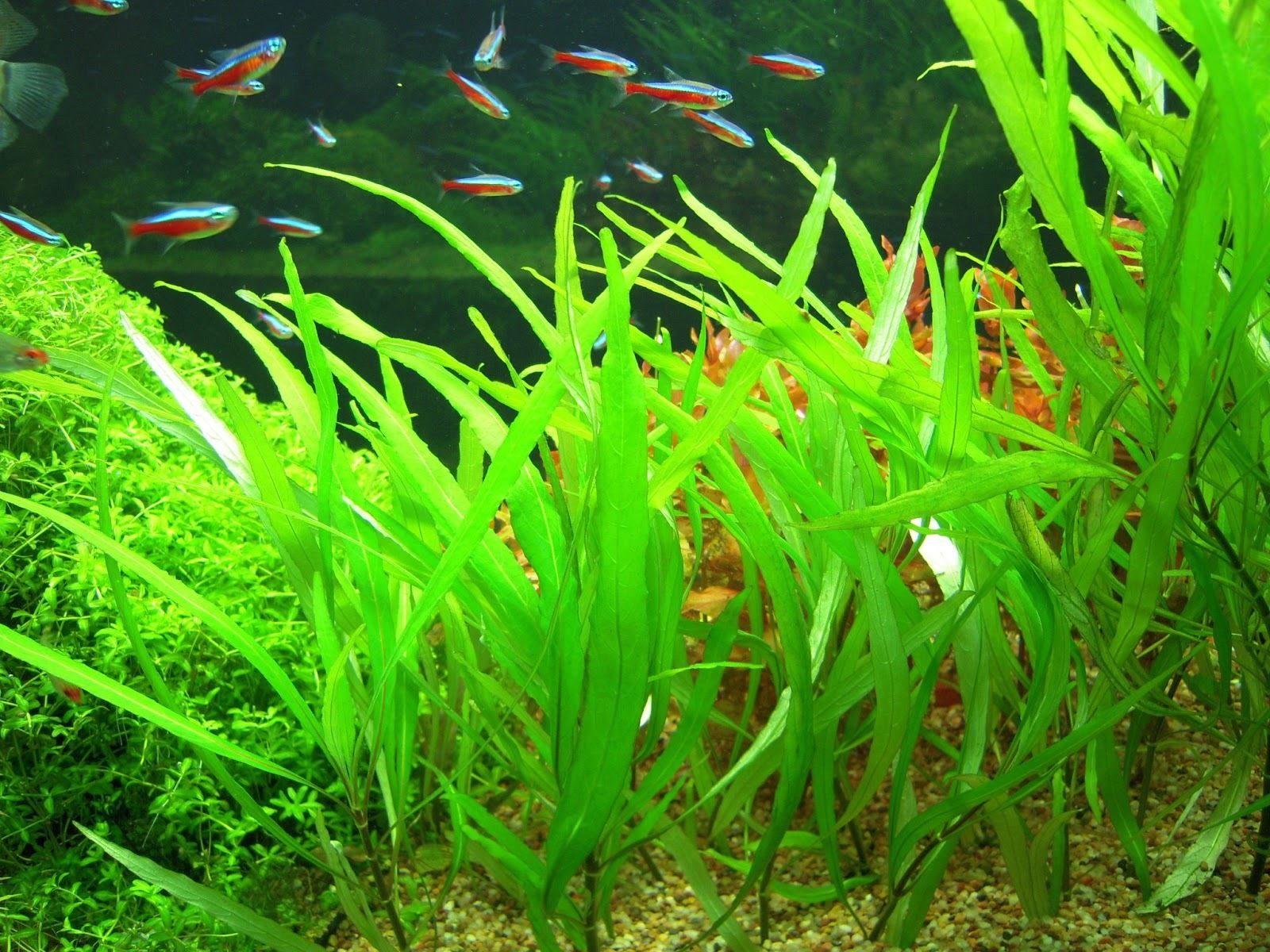 Excessive growth of lower plants is a consequence of a violation of the optimal ratio of light, organic matter and carbon dioxide. Resolving a mismatch is often difficult and time-consuming. It is recommended that biological methods be used whenever possible to eliminate these intruders, as strong chemicals adversely affect the inhabitants of the aquarium.
Excessive growth of lower plants is a consequence of a violation of the optimal ratio of light, organic matter and carbon dioxide. Resolving a mismatch is often difficult and time-consuming. It is recommended that biological methods be used whenever possible to eliminate these intruders, as strong chemicals adversely affect the inhabitants of the aquarium.
Prevention of algae in the aquarium
 Due to the fact that the aquatic environment cannot be sterile, spores, bacteria and various types of microorganisms are constantly present in it. Failure of biobalance can serve as the basis for the rapid growth of algae in the aquarium. To avoid this, you must use:
Due to the fact that the aquatic environment cannot be sterile, spores, bacteria and various types of microorganisms are constantly present in it. Failure of biobalance can serve as the basis for the rapid growth of algae in the aquarium. To avoid this, you must use:
After purchasing new specimens, inspect them carefully before placing them in the aquarium. Get rid of the weakened and damaged immediately. Treat the rest with diluted bleach to disinfect from algal spores. For a 19 parts bleach solution, add 1 part liquid. Place the plant in this mixture for 2 minutes, then rinse thoroughly in running water to remove any residual solution.
Fish are algae
The biological methods of extermination of lower plants include the use of fish and invertebrates that feed on algae and algal bloom. Their colonization, although it cannot guarantee the complete elimination of unwanted inhabitants of your aquarium, will be a serious help in the fight against this problem. Let's list the inhabitants that help to cope with the invasion of algae:


If, despite applying the above measures, you cannot cope with algae in the aquarium, use chemicals that suppress their reproduction. They should be used strictly according to the instructions in order to avoid negative influence on plants.
If you want to get a better understanding of the processes in your home aquarium, it may be worth purchasing a water testing kit. Controlling the content of nitrates, nitrites and ammonia will help maintain the equilibrium of the aquatic environment and avoid possible problems, and in the case of the first signs indicating a deviation of water parameters from the norm, immediately take appropriate measures.
Algae is not all that grows in water. This is the name of the lower, primitive photosynthetic organisms, often consisting of one cell or several cells, collected in a colony or thread. They live everywhere in the aquatic environment. They are distinguished from higher plants by the absence of developed organs: stems, leaves, flowers, and also by the fact that throughout their history they lived exclusively in water, while plants formed on land, and only after that some of them returned to water ...
We plant higher flowering plants (as well as several species of mosses and ferns) to decorate and revitalize the aquarium, while algae, with the exception of the only species that has a decorative value, enter the aquarium without our participation and multiply in it just when the balance is knocked down and balance is disturbed. They form a suspension in the water, causing it to become cloudy or discolored, or they stick to all surfaces in the form of fluff, bundles and balls of threads, plaque, mucus, and the like. It is clear that their presence does not contribute to the beauty of the aquarium.
Algology excursion
 Why does algae sometimes invade an aquarium?
Why does algae sometimes invade an aquarium?
The laws of nature are such that living organisms settle wherever there are suitable conditions for them. The main thing that is needed for the life of algae:
- water;
- light;
- food (macronutrients).
Obviously, all this is in any aquarium.
Algae compete with flowering plants for light and macronutrients. Since the latter are more complex and highly organized, in favorable conditions they win this competitive struggle, restraining the growth of their more primitive microscopic ancestors, taking away their food.
However, those are older, more cunning, more hardy, patient and less demanding. These, of course, are not properties of their character, but features of biology. Algae can form various types of spores and other structures that can survive unfavorable times, they need illumination of a different spectrum, they have different, more quick ways reproduction. And if the conditions in the aquarium are not ideal for the higher flora, there will certainly be a scarlet, diatom or cyanobacterium that will not hesitate to take advantage of this.
There are several divisions of algae that have different colors depending on the pigments they contain. Next, we describe what the representatives of different departments in the aquarium look like and what conditions cause outbreaks in their numbers.
Blue-green (cyanobacteria)
 Their cells do not have nuclei, so these organisms stand alone in the row of algae. In fact, they are bacteria that have acquired the ability to photosynthesis (during it, sugars are formed in living cells using the energy of light from water and carbon dioxide). Despite their low position on the evolutionary ladder, these creatures are extremely tenacious and flexible, and the harm they can do to the aquarium can hardly be overestimated.
Their cells do not have nuclei, so these organisms stand alone in the row of algae. In fact, they are bacteria that have acquired the ability to photosynthesis (during it, sugars are formed in living cells using the energy of light from water and carbon dioxide). Despite their low position on the evolutionary ladder, these creatures are extremely tenacious and flexible, and the harm they can do to the aquarium can hardly be overestimated.
Cyanobacteria form slimy, dark green or bluish films covered with large gas bubbles on the walls of the aquarium, soil, plant leaves, and decorations. All this beauty (and there is really something fascinating, alien in this spectacle) draws in an artificial reservoir with incredible speed, emitting a tangible stench. An outbreak in the number of these organisms can greatly harm plants and fish even in natural conditions (cyanobacteria are the main cause of water bloom in the summer heat), and in an aquarium it is just a disaster that must be fought urgently, and no longer for the sake of returning external attractiveness, but in order to save fish from death.
The reason for the uncontrolled reproduction of blue-green ones is a general failure of the ecological balance, which is caused by a high concentration of organic matter in the water, as well as nitrogen and phosphorus compounds due to systematic overfeeding of fish, irregular cleaning or the death and decomposition of one of the fairly large inhabitants of the aquarium.
The situation is often aggravated by the insufficient amount of oxygen in the water, its alkaline reaction and high temperature.
Red (rhodophytes)
 They are also called crimson. In nature, they are predominantly marine organisms, very complex and peculiarly arranged, with the most interesting life cycles, and just incredibly beautiful. Aquariums are inhabited by such unsightly representatives of them as a Vietnamese woman or a black beard, which are rather nasty brown or almost black tassels, bundles of threads, fringes on the walls, leaves of plants and underwater objects. The threads of flip flops are usually short, 5-10 mm, gathered in brushes or bushes, while in a black beard they are long, up to several centimeters, often branched. Due to the invasion of purple, everything in the aquarium looks dirty and untidy, and plants covered with a continuous carpet of these algae lose their ability to photosynthesize and die quickly enough.
They are also called crimson. In nature, they are predominantly marine organisms, very complex and peculiarly arranged, with the most interesting life cycles, and just incredibly beautiful. Aquariums are inhabited by such unsightly representatives of them as a Vietnamese woman or a black beard, which are rather nasty brown or almost black tassels, bundles of threads, fringes on the walls, leaves of plants and underwater objects. The threads of flip flops are usually short, 5-10 mm, gathered in brushes or bushes, while in a black beard they are long, up to several centimeters, often branched. Due to the invasion of purple, everything in the aquarium looks dirty and untidy, and plants covered with a continuous carpet of these algae lose their ability to photosynthesize and die quickly enough.
The main reason for the appearance of these organisms in the aquarium is the significant pollution of the water, which sometimes becomes almost a broth of dead organic matter.
In addition, a strong current, a high hardness and alkaline reaction of the water, a shift in the light spectrum towards the green (this happens if the lamps are incorrectly selected or if they are used for too long), as well as sunlight from the window onto the aquarium, are important.
Diatoms (brown) algae in the aquarium
 Diatoms are unicellular organisms with a silica shell in the form of a capsule, many of them are capable of movement. The importance of diatoms in natural marine ecosystems is simply colossal, since they make up a significant proportion of plankton and form a huge part of the organic matter of the earth (about a quarter), and their shells, after dying off, are the basis of sedimentary rocks.
Diatoms are unicellular organisms with a silica shell in the form of a capsule, many of them are capable of movement. The importance of diatoms in natural marine ecosystems is simply colossal, since they make up a significant proportion of plankton and form a huge part of the organic matter of the earth (about a quarter), and their shells, after dying off, are the basis of sedimentary rocks.
But in artificial reservoirs, like their counterparts from other departments of lower plants, they are unwanted guests. Brownish or brown algae in the aquarium, forming a slimy coating, especially in poorly lit areas, often near the bottom - these are, as a rule, diatoms. (By the word brown - we mean exclusively color, and not systematic affiliation, since the actual brown algae are a separate section of highly developed marine organisms with large thallus bodies).
Some diatom development almost always occurs in the first weeks after starting a new aquarium. In long-standing aquariums, diatoms appear in conditions of insufficient - weak and short-term - illumination or light of the wrong spectrum, without a blue and red maximum.
Their reproduction is facilitated by a pH above 7.5, high water hardness and a high concentration of nitrogen compounds. An outbreak of diatoms can be caused by an excess of sodium salts in the water, which occurs, for example, after treating fish in a shared aquarium with the addition of table salt.
Chlorophytes (green) algae in the aquarium
In terms of their structure, they are closest to higher plants. Form fringed fouling, bundles, tangles and strands of thin threads or films of different shades Green colour on aquarium glass, soil elements, plants, stones, snags, decorations or green suspension, from which the water becomes cloudy and changes color (the so-called water bloom).
The reasons for their reproduction are usually excessive illumination with a low concentration of carbon dioxide in the water or its uneven supply.
In addition, a lack of macronutrients - nitrogen and phosphorus salts - often leads to the appearance of filamentous forms of green ones. In such cases, the growth of higher plants slows down or completely stops, and the aquarium is overwhelmed with greenish mud.
Fighting algae in the aquarium
 When describing the algae departments, we deliberately described in such detail what conditions the representatives of each of them need in order to multiply in the aquarium to a significant amount (there is always a small number of these organisms in the aquarium, but they do not spoil the beauty and do not interfere with other inhabitants). Obviously, in order to cope with the invasion of purple, diatoms or their counterparts, these conditions in the aquarium must be changed. And the most important thing is to plant a large number of living higher plants and create conditions under which they can successfully compete with algae and thereby control their numbers. The following steps will help you change the balance of power in favor of plants.
When describing the algae departments, we deliberately described in such detail what conditions the representatives of each of them need in order to multiply in the aquarium to a significant amount (there is always a small number of these organisms in the aquarium, but they do not spoil the beauty and do not interfere with other inhabitants). Obviously, in order to cope with the invasion of purple, diatoms or their counterparts, these conditions in the aquarium must be changed. And the most important thing is to plant a large number of living higher plants and create conditions under which they can successfully compete with algae and thereby control their numbers. The following steps will help you change the balance of power in favor of plants.
Illumination correction
It is necessary to shift the illumination parameters to the side that is inconvenient for algae and convenient for plants. In the case of crimson and diatoms, the strength and duration of illumination must be increased by a more careful selection of lamps or the installation of additional ones. The maxima of the lamps should be in the blue and red regions of the spectrum. In the case of a strong development of chlorophyte fouling, the light intensity and the duration of the light period, on the contrary, decrease.
When water blooms or an outbreak of cyanobacteria, the lamps are completely turned off for several days, sometimes while the aquarium is additionally covered with cloth or paper so that even scattered sunlight and room light cannot get on it. Higher plants will survive this (except for the most delicate ones, which are better for now to be removed to another container), and algae will die.
Nutrients
To suppress the growth of the lower algal flora in the aquarium, a balance of nutrients must be maintained. Dissolved organic matter in water should be as small as possible, and there should be a sufficient amount of macroelements (nitrogen and phosphorus compounds), but not an excess amount. This requires regular cleaning of the aquarium, siphoning the bottom, water changes of a quarter or a third a week, depending on the density of the aquarium population.
The lack of nutrients in the aquarium is less common than their excess, and is usually observed in herbalists with a very high planting density and a small animal population. In such situations, the issue is solved by applying fertilizers, while they must be placed in the ground, directly to the roots of the plants. Easy-to-use and currently available aquarium tests can accurately measure the concentration of various compounds in water.
Carbon dioxide
Introducing CO2 into the aquarium with various devices provides plants with a source of carbon and, in the presence of good lighting, can significantly change the balance of power in their favor. In addition, carbon dioxide acidifies water, which also usually has an adverse effect on the lower flora and beneficially on the higher one.
In addition to these basic measures aimed at improving the conditions for plant growth and normalizing the general situation in the aquarium, the following are used to combat algae:
- mechanical removal of them from surfaces with a scraper or toothbrush;
- settling algae-eating fish in the aquarium (ototsinkluses are effective against diatoms, SAE against purple and filamentous chlorophytes, labeo and girinoheilus - against scale greens) or, in the case of water bloom, cladocerans of daphnia;
- in rare cases (for example, an outbreak of cyanobacteria or water bloom), the use of chemical control methods is justified - antibiotics and algicides, as well as an ultraviolet sterilizer.
I must say that the massive development of cyanobacteria is a reason for taking emergency measures: in addition to the already mentioned complete darkening and the use of an antibiotic and a sterilizer, it is necessary to deprive algae of nutrients as much as possible. To do this, they stop feeding the fish in the aquarium (it is generally better to resettle the fish for a while), set the filter flow power to a minimum, while simultaneously turning on the aeration, do not make water changes. After the death of most of the blue-green ones, a general cleaning of the aquarium is carried out with a deep siphon of the soil and the replacement of most of the water.
But such measures for the destruction of algae give only a temporary effect, which quickly passes without normalizing the overall balance of the aquarium. Therefore, with all due respect to the ancient origin and the huge ecological role of algae, let's try to create conditions in our aquarium under which not they will feel comfortable, but those for whom we start our indoor reservoirs - higher plants and fish.
voted 1 , rating: 5,00 out of 5
How to get rid of algae in your aquarium? My reader, you have no idea how glad I am! Finally, a global problem was solved in an accessible way. There are hundreds of tips on the Internet on how to get rid of this scum. Moreover, the more clever and longer the article, the more valuable it is. Right? After all, there are so many details about algae!
And the poor aquarist wrenches his brains from the contradictory advice, going from site to site. Either you need a lot of light, then you need to reduce the amount of it. Either turn off the lamps for a few days, then turn it on on the contrary. Yes, not simple ones from a hardware store, but specialized ones for plants. Either pour fertilizer or don’t. I will not write a scientific article about aquarium algae and their varieties. I'd better teach you what to do. But I'll tell my story in order.
My aquarium is small by today's standards - 170 liters. There is an eternal problem in it - the plants grow somehow sluggishly. The depth is great - a column of water 60 cm. Who would argue: it is dark at the bottom. I would add light, but even without that, the lamps heat the water up to 28 degrees. The optimum temperature for plants is 24-26. Plants survive painfully from overheating and get sick. To keep the plants comfortable, I use a nutritious substrate under the soil. I bought Tetra CompleteSubstrate twice. But it is not eternal, it depletes in a year. Once again, it was decided instead of the proprietary substrate.
Ordinary vegetable garden from the garden, not from the store. Because the latter contains not earth, but a mixture of peat. No sooner said than done. The plants burst into growth wildly, especially raging, scattering a dozen children around the mother bush. For four months everything was great, then I went on vacation for 3 weeks. My husband fed my fish farm "from the belly", and my "beggars" were only glad of this. The lighting for a dozen aquariums was in charge, so I was not particularly worried.
I returned to the swamp. The entire aquarium (this very problematic one) became depressed, the plants took on an unhealthy yellowish tint. Because both glasses and plants are covered with brown (diatom) algae. Usually in such cases they say: dim lamps, little light. This statement wanders from site to site. Whatever it is. There are many reasons for this, I will list them all.
Naturally, I grabbed my head. Experiments with earth failed again! We urgently need to remove it. And it took me to the other extreme: I decided to use ordinary river sand as a soil. As you know, there is nothing useful for plants in it. Plants do not grow in bare sand! This is for the information for beginners who stick the flakes in the sand and are surprised that it has dissolved in a couple of weeks. It was decided to use unwashed river sand as the bottom layer, and clean on top. I didn't take it out of the water. I dug it up on the bank about five meters from the river. A bit of liquid fertilizer in the water, a bit - under the roots. Also liquid, with such a syringe.

This is another experiment of mine.
As a result, I lost my entire population of nymphs. They quietly shed their leaves and dissolved, not trying to settle down in the new soil. It took 4 months to kill all the plants. And brown algae still dominated the aquarium. Not so violently, but the underwater landscape somehow did not please with a faded yellowness. My aquarium has seen completely different times, and the plants in it delighted the eye with bright green freshness. Wiping diatoms off the glass once a week is not a problem. Who was so self-confident who suggested washing them off the plants? Storyteller. Plants slowly die under the layer of diatom plaque, because the process of chlorophyll formation in them stops. Of course, without light under a layer of algal fouling, what kind of life?
The next action in the struggle for the prosperity of plants in my aquas was the replacement of the river soil with a nice purchased one. I remember that 33 kilos I brought him home exactly on New Year's Eve.

Small rounded pebbles, fraction of about 0.3-0.4 mm.

Down below the roots I planned a layer of AQUAYER nutrient mat.
I bought a substrate in an online store. City shops do not practice such a miracle. Dense, however. To order, we also could not find this particular fertilizer. Thanks to the internet and the friendship with the computer.

I bought new plants. Quite a lot of willow hygrophila. And she restarted the aquarium. Naturally, I know that 3 blades of grass are not an option for restarting. There should be a lot of plants at once, preference is for fast-growing ones. You know, even my hornwort turned yellow after 2 weeks! From diatoms. They are brown! Covering the plants, they give a yellow tint. In general - phew ... Not that it was completely awful, but initially, when the hygrophil was planted, it was greener.
What is the reason? Roy meticulously once again the internet. I remove a dozen barbs from the aquarium. Firstly, the rodents are still those, and strive to bite something. Mine got used to eating young Anubias leaves. Secondly, barbus excrement - do not eat good fertilizer for plants. So it turns out! According to numerous observations, plants in aquariums of live-bearers feel great. This is, apparently, by analogy: cow and chicken manure is an excellent fertilizer for the garden. And pork - no, no! We strain our brains and remember what they eat.
And so, down with the barbs. The next reason is the new soil from which the silicates are spun. Here - just wait and endure. There is some kind of tricky chemistry from silicates in the Chinese. Came across on taobao, but did not order. I decided to wait for the soil to "age" naturally.
Another reason is fish overfeeding. Too much organic matter dissolved in the water. Hence - also diatoms. Yes, sinful. Grown up in the aquarium 4 shark ball.
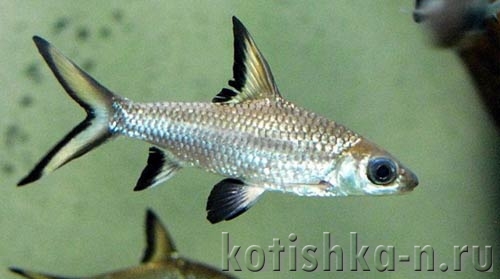
Handsome men among small things. They have to be supplemented with additional non-small "croutons". Quite good food made in China, fish grows well on it. But in an aquarium with live plants, it is best to keep small fish. She eats little and crap little. Yeah.
In addition to the above, balu sharks are also barbs. Like this. I decided to part with them. She replaced the barbs with a dozen Australian melanothenies, and the shark balu with the koi scalar. Here is such a castling.
The fight against algae is over!
And you know, finally, brown diatoms receded!
- The soil has “aged” and has ceased to release silicates.
- I parted with fiery and Sumatran barbs.
- The sharks have moved to the ball to other owners, thanks to a nearby pet store. They left a week later for a neighboring town.
- A dozen tireless velifer snowflakes have appeared in the aquarium. They diligently pinch any fouling. There is little sense from them. But they are live bearers. I have one labeo, caught it from a small "little house" and sent it to graze in a problem aquarium. This scoundrel ate my ludwigia bush in one day. Almost all of the delicate leaves are covered with his "grater". I had to catch up with a butterfly net and send it back to the place of registration. For the same reason, she did not start algae eaters. Get carried away and spoil something.
- The fish began to feed much more moderately than before, since the remaining eaters are not so gluttonous.

Something else? Well, of course! I added lighting! Has ordered an amazing LED lamp from China. Light now - like in Africa on a sunny day. The plants were delighted and cheered up. In just a month, the half-empty aquarium was filled with plants. These are no longer purchased, but grown by me. While the aquarium was problematic, it made no sense to plant something valuable in it. Lower leaves from poor lighting will be shed. Diatoms will not allow plants to fully live and develop.
Now I boldly transplanted into the aquarium a couple of viviparous aponogetons, 3 limnophila branches, a rajah nymph bush, ludwigia, and a hygrophilous cinem. And the yellow cryptocarina smelled and settled itself in the foreground, filling the free space. Hornwort bunches - down with. He was happily picked up by a nearby pet store. While I was struggling with diatoms, I was afraid to remove the hornwort. He honestly held the defense, taking the blow on himself and protecting my fragile plants, which were in no hurry to rage among the algae.
But guys, where there is a lot of light - wait for the invasion of green algae! I have long ago turned on my brains in the direction of sidex. This is a commercial proprietary name. The chemical itself is glutaraldehyde. It is used in the fight against algae in the aquarium.
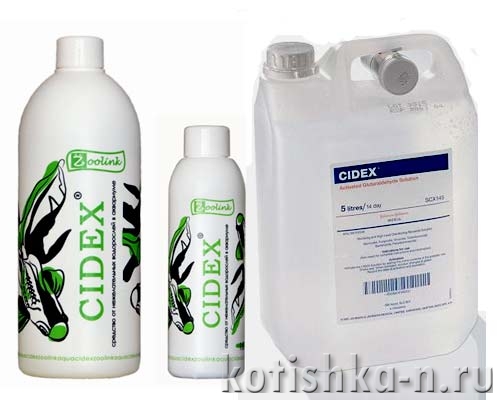
And the trade name can be anything you like. There are many of these drugs. They all contain 2.5% glutaraldehyde. The manufacturer sells it in liters as a sidex.

The Chinese - a concentrated solution in small glass bottles. It is very convenient: you dilute 1 part of the concentrate (the whole bottle) in ½ liter of water. And you get the same 2.5% glutaraldehyde to fight algae. In fact, such a bottle on taobao costs mere pennies, but shipping from China is expensive.
Aquarists have long been accustomed to using sidex “for peaceful purposes”. Who said that the aquarium should be brought to disgrace, and then treated with bad doses of glutaraldehyde?
It must be applied wisely! The daily dose is 4-5 ml per 100 liters (it is better to start carefully with 3 ml), or 1 ml for 30 liters. In such a concentration, it is not only harmless to fish and plants. He's useful! When decaying, it serves as an additional source of CO2, being a plant nutrition and beneficial bacteria... 99% of the carbon supplied from the cylinder escapes into the atmosphere, and the carbon released by glutaraldehyde during its half-life, as well as other useful substances (aspartic acid, fumarate, glutamic acid), act as excellent stimulators of the growth of aquarium plants.

Sidex is not to be found in our city. The most affordable and cheapest option is Aquastop (made by Zoomir). Instruction information about chemical composition he is slyly silent. Probably so as not to traumatize the imagination of particularly touchy consumers. They will immediately begin to count the 100 gram bottle in arithmetic proportion. And to compare: how much 100 grams of sidex cost, and how much - 100 grams of Aquastop. I will not compare, I am quite satisfied with the cost of Aquastop. And its walking distance in a nearby store.
Aquastop - review and results
The most pesky algae are all gone! The glasses do not turn green, the plants are clean! It remains to finish off the Vietnamese and thread. Even small doses will not give them a chance, you just have to wait a month or two. I have a Vietnamese woman here and there from the current, and from fertilizers. Plants want to eat! It is necessary to fertilize. Algae do not sleep at the same time. We sat down to the "feeding trough". In addition, there is a current in my aquariums, whatever one may say, but in the area of \ u200b \ u200bthe filters it is.

The same aquarium 3 weeks later. Plants loved the LED Chinese lamp!
In general, I eventually found a panacea. In the morning I feed the fish, and in all the aquariums I fire-burn - I spray Aquastop from a bottle. It is not difficult to calculate. One press on the bottle is equal to 1 gram. I measured the volume with a syringe. It's easy to get used to it. For the sake of interest and to expand your horizons, you can examine aquarium algae even with a microscope, trying to identify your problem. They are green there you have, brown or black, with dots on glass or tassels on plants. Interesting - delve into. Better yet, take action. Aquastop works against all types of aquarium algae.
P.S. Whoever has the opportunity to purchase Sidex - try to use it. The dosage is the same. And the plants are happy, and there are no algae!
Algae in the aquarium, photos and names









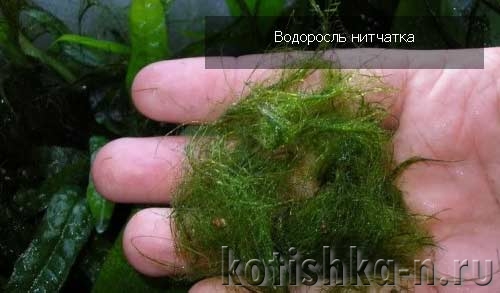

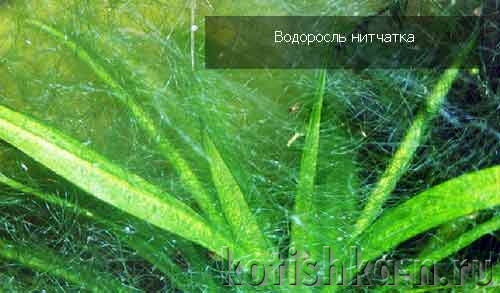








THANK YOU FOR SHARING THIS ARTICLE ON SOCIAL MEDIA


